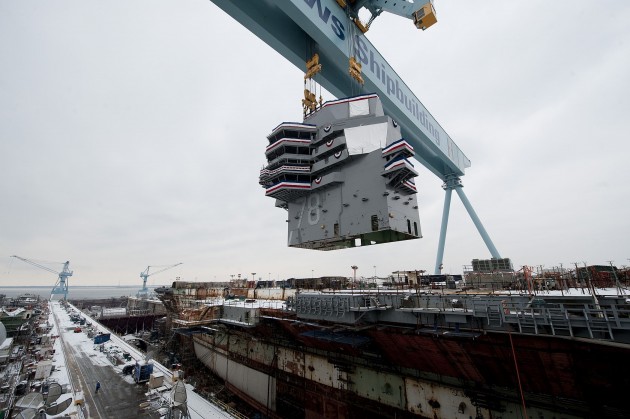Rep. Forbes Pledges Tougher Oversight; Carrier Costs, LCS Mission, Size of Fleet
Posted on

The nuclear carrier USS Ford (CVN-78) under construction at Newport News Shipbuilding.
CAPITOL HILL: Yes, the defense budget is a mess. Continued uncertainty about whether sequestration will go away or is the new norm has thrown the annual budget process into even greater disarray than usual. But, Rep. Randy Forbes believes there’s a silver lining. Precisely because the president’s budget request is largely overtaken by events, Congress has a historic opportunity to reassert its role defining Pentagon programs, Forbes told me in an interview in his Capitol Hill office this morning. He called it a “rebirth” of oversight.
As chairman of the of the House Armed Services seapower and projection forces subcommittee, Forbes intends to use next week’s legislative markup and the whole authorization process that follows to ask tough questions – and maybe to impose new reporting requirements – about three key issues in particular:
- The spiraling costs of the Navy’s new Ford-class aircraft carrier;
- The ill-defined mission of the Littoral Combat Ship;
- Just how small the fleet will get if shipbuilding dollars stay at their present levels, without the implausible return to Reagan-era spending levels currently assumed in the Navy’s 30-year shipbuilding plan.
“With every enormous challenge, there are also great opportunities,” Forbes said. “The president’s tardiness in bringing his budget is what rendered his budget somewhat meaningless, because it came in after the House and Senate budget – and Lord only knows when the planets move and the Senate can do a budget [which it has not in prior years]. He probably deserves to be relegated to less significance…. It also gives us [Congress] a greater degree of opportunity to really do the authorization and really set long-term goals and policy.”
Playing that role will require Congress to go beyond the annual budget hearings and hold the military to meeting “milestones” throughout the year, said Forbes. That’s particularly important for troubled programs like the next-generation aircraft carrier, the 1,000-foot-long CVN-78 Gerald R. Ford, and, at the other end of the spectrum, the 400-foot-long Littoral Combat Ship. Only such continuous oversight, Forbes said, can “make sure that we’re not meeting on these issues [once] and coming back a year from now and saying, ‘oh my gosh, we’re a billion dollars short.’”
That $1 billion is the increase in the estimated cost for the USS Ford. “All of us worry as we see these numbers,” Forbes said. Nevertheless, “I think you will see us approving that increase, even though we know some of our friends in the Senate will be pushing back on that.”
“Like it or not, we can wring our hands, we can stomp around like Rumpelstiltskin if we want to, but we need these carriers,” Forbes said flatly. The flattops are still the core of America’s naval power, he said, noting that the fleet has already shrunk to 12 to 11 to 10, and going down to nine is “not acceptable.”
The $1 billion overrun is definitely disturbing, he acknowledged. Congress needs to put “pressure on both the Navy and the contractor,” Huntington-Ingalls, to keep costs in line, and “I give [Navy Assistant Secretary for Acquisition Sean] Stackley some pretty high marks on attempting to do that.” But cost concerns cannot override strategic demands, Forbes said: “At the end of the day we’re going to build carriers.”
The same can’t necessarily be said of the Littoral Combat Ship, whose survivability in combat has been repeatedly questioned. “We’ll see probably four of those in FY ’14, but we’re not wedded to that being forever,” Forbes said. “Nobody questions is it a good boat… The question is, does it fit in with what we need? Is it a police boat or is it a navy boat?”
“The worry I have is that the Navy doesn’t know yet,” Forbes said. Some basic questions about the LCS class’s role are still unanswered: “It’s kind of like the guy that goes to the supermarket and says, ‘well, this is good, I’ll throw it in my basket, and maybe I can fix something with it later.’”
Forbes also repeated his support for the Navy’s next-generation drone, the UCLASS (Unmanned Carrier-Launched Surveillance And Strike System), citing this week’s successful launch of an experimental proto-prototype, the X-47B – although “even if it had failed, [UCLASS] is going to be a necessity.”
Forbes said he’s also committed to building up the Navy’s fleet of destroyers and forbidding retirements of aging cruisers and amphibious warfare ships. As a nation, Forbes argued, “our priority over the next decade, maybe two or three decades, is going to have to be to rebuild the Navy.”
The service’s official 30-year shipbuilding plan, however, is “fantasy,” assuming future increases in funding to levels Stackley himself has acknowledged the Navy has not seen since the Reagan buildup. If shipbuilding continues at its current funding level, Forbes estimated, far from rising to the officially required 306 ships, the Navy is likely to shrink to about 250.
“Either in this mark or sometime down the road,” Forbes said, the committee may well require that “the Navy actually give us a report on what our fleet size will look like if we maintain the current levels of funding for shipbuilding that we have.”
Forcing such an official acknowledgement that the fleet will shrink without additional funds, Forbes believes, will be a powerful tool in making the Navy’s case to the American people and to Congress as a whole. “Some of this has to go beyond even our subcommittee or our full committee,” he said. “We need to do a better job at providing information to people who don’t sit on the defense committees… and let them realize what sequestration is doing.”
Updated 7:45 am, May 17, to replace incorrect photo.
Subscribe to our newsletter
Promotions, new products and sales. Directly to your inbox.
